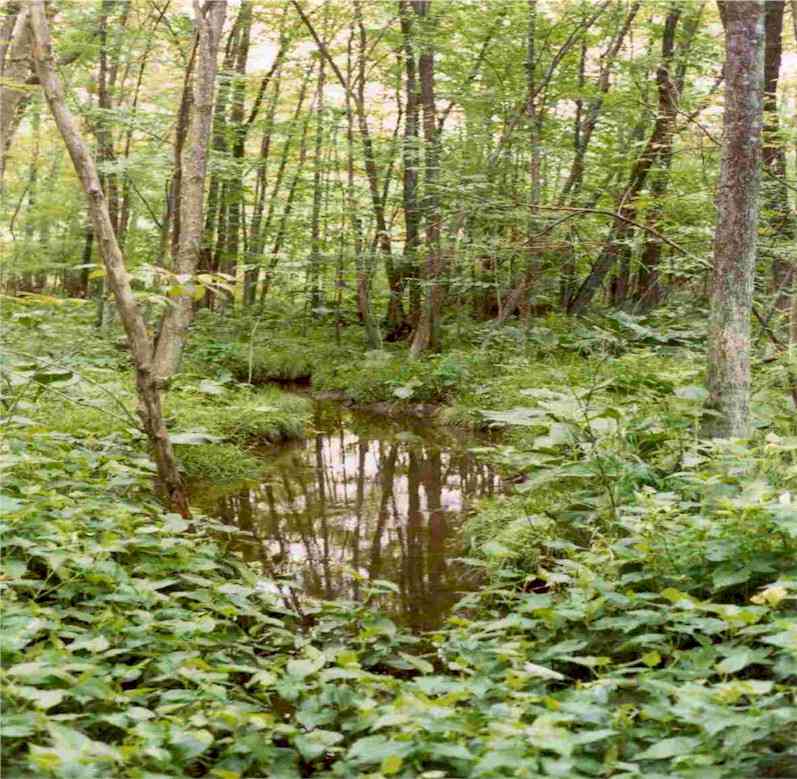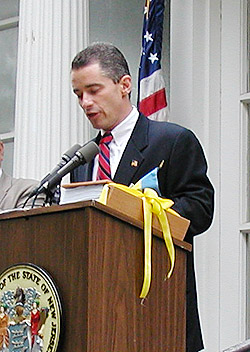New Jersey's Own
Great Swamp National Wildlife RefugePlans to protect air and water, wilderness and wildlife are in fact plans to protect man. - Stewart L Udall
Wetlands are defined as "lands of transition between terrestrial and aquatic systems where the water table is usually at or near the surface or the land is covered by shallow water." Throughout history, wetlands has often been regarded as useless land. The American government has actively encouraged development of these areas. In 1845 Florida's legislature described the vast wetlands system of southern Florida, remnants of which are now Everglades National Park, as "wholly valueless." According to the US Department of the Interior, more than 100 million acres - 54% - of American wetlands have consequently been destroyed. Maybe Americans acted hastily... The Great Swamp is a remnant of a large Pleistocene glacial lake known as Glacial Lake Passaic, formed by the meltwaters of the Wisconsin Glacier 12 to 15,000 years ago. These meltwaters filled a large natural basin beside the Watchung Mountains. At its largest, Lake Passaic was 30 miles long, 10 miles wide and 200 feet deep. It extended from Morristown to New Providence, Basking Ridge to Lincoln Park. In 1959, the New York Port Authority wanted to turn the Great Swamp into the metropolitan area's fourth jetport (all that flat land!) but homeowners in the area and conservationists who appreciated swamps raised money and bought up much of the acreage involved (3,000 acres). This comprises the nucleus of the refuge, two-thirds of which is protected by the Wilderness Act of 1964 which mandates it be kept "forever wild". Unfortunately, many people today still believe "worthless" swamp land should be developed into something that will generate revenue. They don't seem to understand that because its usefulness is not readily apparent to them, this does not mean it is truly worthless. Swamps provide benefits including flood prevention, water pollution control, soil erosion and sediment control, stream baseflows, wildlife habitat, and educational and aesthetic values. If it would make people appreciate swamps more, monetary values and savings can easily be associated with each of these benefits. Swamps are an integral part of many ecosystems for their role in the hydrologic cycle and for the habitat they provide. Swamps regulate temperature and humidity, prevent floods, provide recreation opportunities including bird watching, regulate river flow, and naturally filter water. New Jersey’s swamps have already sustained immense damage (see the article immediately below); the environment reflects this degradation. Flooding has become more of a problem, the hydrologic cycle is degraded from a multitude of sources, and swamp-dwelling species are declining steadily while deer become an ever-increasing danger. Swamps that have already been developed are expensive to restore so restoration is not always the answer (although it sometimes is - see the article "Restoration Drama" below). Certainly in the future no further swamp development more disturbing than placing walkways should be undertaken. Swamps can be extremely beneficial to all, with only minor inconveniences (other than possibly lost financial opportunities to a select few). Steps can and should be taken to minimise swamps’ drawbacks and maximise beneficial possibilities. The Great Swamp National Wildlife Refuge is a place of great beauty and of significant ecological importance. Unfortunately, its status as a wildlife refuge is an unusual one, rather than the norm. Another, similar, swamp in Morris County is called Troy Meadows. In the late 1930s the US Fish and Wildlife Service proposed Troy Meadows as a national wildlife refuge to serve the greater New York metropolitan region, but the designation was never granted. Since the early 1950s Troy Meadows has been reduced to half its original size. It continues to be endangered by development all around it. In 1954 the US Dept of Interior rated Troy Meadows as the "only high quality inland wetland in the state of NJ" (a rating even higher than that of the Great Swamp). In 1961 the state of NJ announced Troy Meadows as one of its first Green Acres Projects; however, the state today owns only about 20% of the land with the major portion still in private hands. The 3,100 acres of uplands and wetlands at Troy Meadows covers wide swaths of Parsippany, Hanover and East Hanover. Wildlife Preserves, a non-profit corporation, owns about 1,700 acres of the state-designated natural area, which serves as a sanctuary for plants and animals. The corporation has preserved and protected the land for more than 40 years, but it is a private entity, and protection and enforcement are costly. State acquisition could guarantee the land's protection for centuries. Preserving the land would save more money in flood prevention than would be raised through taxes by development, according to Wildlife Preserves. But so far, nothing has been decided. Meanwhile, Meadowlands in East Rutherford, another large and ecologically important swamp, will be developed because - well, because it has already been spoiled. Enough material to fill Giant Stadium will be spread over hundreds of acres of rotting landfills of household garbage, discarded refrigerators and industrial waste, sealing the source of decades of wetlands contamination. This will allow EnCap Golf Holdings to transform the dumps into four 18 hole golf courses, 3500 housing units, hotels, offices, restaurants, a world class sports and recreation complex, an equestrian centre, and tennis and marina facilities. Environmental watchdogs are raising concerns that the state is allowing EnCap too many shortcuts. The materials used to cap the landfill - dredged soils and dried sewage sludge - may have their own contaminates. The sealed perimeter may not be watertight. Since the 1950s, before the state started regulating garbage dumps, millions of tons of waste were dumped on more than 1,000 acres in the Meadowlands. One dump is more than 100 feet high. The full extent of what is buried is unknown. Now when it rains, water seeps through the trash picking up contaminates, becoming a dark smelly and hazardous leachate which discharges into the wetlands and ground water. In recent years, ground water and stream water testing has shown signs of carcinogenic PCBs, metals, pesticides and other toxins. According to the NJ Department of Environmental Protection, the entire cap will be made up of 3.2 million cubic yards of dredged soils and nearly 1 million cubic yards of other recycled material, including about 14,000 truckloads (250,000 tons) of sewage sludge from the Passaic Valley Sewerage Commission. Once the dumps are capped, a skirt of impermeable plastic or steel barrier wall will contain drains to collect toxic leachate seeping through the cap which will be pumped to the sewer authority for treatment. The walls will be driven 15 feet into the natural layer of clay known as meadow mat and the barrier layer will be tied to the wall. Environmentalists question just how impermeable these barriers are. Further, it has been suggested that this project has more liberal permeability standards than other state landfill closures. Traditionally NJ landfills have been capped with either an impervious synthetic liner or a layer of clay that is nearly water tight. Both can cost millions. But no caps are perfect - synthetic liners can rip and clay can crack. The general guidelines allow water to pass through at a rate of no more than an inch per year. EnCap will line one landfill with an impervious liner, but DEP will allow the others a permeability rate 200 times higher than the accepted standard rate because some of the soils dredged from the harbour will have a higher concentration of sand, so the standard rate cannot be guaranteed. Using dredge materials will not only save EnCap from spending money on a synthetic liner or clay cap, but generate revenue for them at $5.23 per cubic yard - or more than $16 million dollars. Using sewage sludge contaminates worries environmentalists. Concerns are that if the cap is not tight enough, the sludge containing heavy metals, PCB's, lead, arsenic, cadmium, chromium and so forth will leach into the ground water. EnCap agreed to dispose of the sludge in exchange for reduced leachate treatment costs with the Passaic Valley Sewerage Commission. DEP states it will monitor contaminate levels of the sludge and says it tests material before being unloaded. Dredged soils and silts are tested by the Army Corps of Engineers and checked by the state. They say any material found to contain hazardous levels of toxins or metals or foul smells will be rejected. Which swamp sounds like the best one to have as a neighbour? Measowlands, I guess - if you like golf and tennis. Troy Meadows or the Great Swamp if you value the earth and a long life...
$1.3B, 4.8MSF Xanadu Project Will Transform "Swamps of Jersey"[We stand] today poised on a pinnacle of wealth and power, yet we live in a land of vanishing beauty, - Stewart L Udall
Big digs: The Meadowlands Xanadu project (pictured in an artist's rendering) by Jack Lyne East Rutherford, NJ - Something big - 4.76 million sq ft (428,400 sq m) of it - is brewing out in what Garden State favourite son Bruce Springsteen once called "the swamps of Jersey." That large-scale swamp thing is Meadowlands Xanadu, (meadowlandsmills.com) a $1.3-billion mixed-use project just west of New York City in the New Jersey Meadowlands. The ambitiously sprawling venture is scheduled to break ground by year's end on a 104-acre (42-hectare) site in East Rutherford - lawsuits permitting. And there's a lot of ground to break: the project will include 1.8 million sq ft (162,000sq m) of office space, 1.7 million sq ft (153,000sq m) of entertainment attractions, and 594,000sq ft (53,460sq m) of retail operations. The mega-project has attracted some high-profile champions, one of the most significant being New Jersey Governor James McGreevey (D). "For years, the Meadowlands region has been thought of as Jersey's great swampland, a mere suburb of New York, or, even worse, a garbage dump," McGreevey told a recent Meadowlands Regional Chamber of Commerce meeting. "Its potential has been ignored for too long. We're going to change that and in the process create jobs, economic opportunity and a model for smart growth development." Redeveloping the Meadowlands, McGreevey asserted, is "a top priority for our administration."
"The Meadowlands region has been thought of as Jersey's great swampland, No surprise there. The project's job-generation punch is a priority grabber. Meadowlands Xanadu will create an estimated 20,000 new full-time jobs, plus 21,000-plus construction jobs over the scheduled six-year build-out. Then there's the very large tax angle. The venture will add an estimated $133 million each year to state and local coffers. With regional tax-sharing, East Rutherford and the surrounding communities "will experience an almost 10-fold increase in tax payments [with] $250 million projected in the first 20 years of operation," McGreevey said. Winning Mills/Mack-Cali Bid Includes Striking Range of ElementsIt takes a gob of activity to generate that much job and revenue action. But activity writ very large is Xanadu's essence. Those activities were part of the plan submitted by The Mills Corporation (www.millscorp.com) and Mack-Cali Realty Corporation (www.mack-cali.com). The Mills/Mack-Cali bid got the nod for the project in February from the New Jersey Sports and Exposition Authority, topping rival proposals by Forest City Ratner/Hartz Mountain and Westfield America Trust. "All of the proposals were exceptional, but Mills/Mack-Cali stood head and shoulders above the rest," said Carl Goldberg, chairman of the sports authority's selection committee.
Xanadu, says Mills Corporation Chairman and CEO Laurence Siegel, One of the design's standout features is its striking range. Only a few major components include:
Mills Corporation Chairman and CEO Laurence Siegel calls Xanadu "our crown jewel, the bellwether by which all other developments will be measured." Project Part of Nets/Devils Retention EffortThe project could also figure in whether the Meadowlands retains the NBA's New Jersey Nets and the NHL's New Jersey Devils. The two teams are considering relocating to Newark from their current home in Continental Airlines Arena. The Mills/Mack-Cali proposal preserves the current arena, leaving it to the state to determine the building's future. Xanadu, however, could aid the Nets/Devils retention. The Mills/Mack-Cali team is paying the state $160 million as part of its winning bid. That, in turn, will save New Jersey taxpayers the current Continental Arena's $100 million in outstanding debt. In addition, local officials are touting Xanadu as an attendance-boosting draw for the two teams. The bigger issue, though, revolves around the $355-million proposal to rebuild Continental Arena. A new arena would more than triple the current facility's 29 luxury suites, which are major revenue generators. No question, though, about the continued presence of the NFL's New York Giants, who play at Giants Stadium next to the Continental Arena. "The Xanadu proposal provides maximum entertainment and recreation to the region and is a perfect complement to the Giants organisation," said Giants Executive Vice President John Mara. "We believe Xanadu will seriously enhance our opportunity to bring a Super Bowl to the Meadowlands in the near future."
Major Xanadu supporters include the New York Giants football team and star Michael Strahan, Giants star Michael Strahan also backed Xanadu at a June public forum soliciting public input. "I think it actually adds another dimension," Strahan said. "When people come to the Meadowlands now, it won't only be for a sports event. There'll be other things for you to do. There'll be things to entertain adults, things to entertain kids, shopping, hotels. You name it, it will be here." Losing Bidders Try to Halt ProcessThere, too, is the opposition invariably accompanying projects of such size. Xanadu's biggest challenge, though, has come from the two teams that submitted losing bids. Hartz Mountain filed a lawsuit in March seeking to enjoin the New Jersey Sports and Exposition Authority from finalising the Mills/Mack-Cali contract. That suit was dismissed in May. But Westfield America Trust initiated similar action in June. Its formal protest contends that Xanadu would exceed the RFP's prescribed boundaries and that the ballpark "appears to be the dimensions of a Little League field." Westfield also argues that the Mills/Mack-Cali proposal would fill in an eight-acre (3.2-hectare) tidal wetland area that Westfield's proposal would've preserved. Westfield's protest is holding up finalising the Xanadu contract and breaking ground. Initially, officials hoped all that would be done by August. Xanadu also raises major infrastructure issues for the state. "Access and infrastructure planning will be a key factor in determining our success," McGreevey said. "Families can't visit and shoppers can't spend if they're stuck in traffic on Route 3." The state is making $395 million in transportation improvements this year in Bergen and Hudson counties, including extending light rail and opening a Secaucus transfer station. More infrastructure funding, though, will be needed to accommodate Xanadu - not an easy proposition given New Jersey's $5-billion deficit.
A major factor auguring well for Xanadu's success is its proximity to New York City, Environmental IssuesIn addition, Xanadu has environmental hurdles remaining. Likely the most significant is securing permits to build on the tidal wetlands. Surprisingly, though, little high-profile environmental resistance remains. Xanadu helped its case with a contractual provision for the Mills Corporation to donate open space and wetlands to the state. The offer, which takes effect with the final agreement's signing, gives the state the 587-acre (235-hectare) "Empire Tract" on which Mills proposed a Meadowlands Mills mega-mall in 1998. Similarly, the state's Meadowlands redevelopment plan stresses environmental friendliness. That plan calls for 45 acres (18 hectares) of parks, biking and hiking trails, and 1,250 acres (500 hectares) of open space. The state design will also convert 950 more acres (380 hectares) of landfills into golf courses, a resort and a residential, pedestrian-focused village. "New Jersey must change the way we think about economic development," McGreevey emphasised. "We cannot sacrifice our drinking water, farmland and open spaces in the name of economic progress." He added, however, "Smart growth does not mean no growth." Jack Lyne is the executive editor of Interactive Publishing Source: conway.com
One wonders why environmental groups have been silent. Do they think a fight would be a waste of resources because, given the money involved and the power of the backers of Xanadu, they are likely to fail? Perhaps they think the deal they've been offered is the best they are likely to get? Yet it should not/need not be that way. The dump has not ruined the wetlands forever. Read on...
Restoration DramaOver the long haul of life on this planet, it is the ecologists, and not the bookkeepers of business, who are the ultimate accountants. Stewart L Udall
The science of ecology is helping to bring "ecosystem services" to market Restoring damaged habitats to something like their pristine condition is a relatively recent idea. For most of humanity's history, the trend has been in the opposite direction, as people have logged forests, drained marshes and cleared land for agriculture. But as folk have grown more knowledgeable, they have realised that some habitats are useful in their original condition. The result is an increasing desire to recover part of what has been lost. That is helping to change ecology from an academic to a practical science, as the subject's insights are applied both to the task of restoration and to hard-headed assessments of the value of that restoration. To help the flow of theory into practice, Margaret Palmer, a biologist at the University of Maryland, ran a symposium on the subject at a recent meeting of the Ecological Society of America and the Society for Ecological Restoration, in Tucson, Arizona. According to Dr Palmer, every habitat has an "envelope" of natural variation in its possible structure and composition. Knowing what lies within this envelope is crucial to knowing what to restore, and when to stop. Thus, successful habitat restoration requires an understanding of theories about population biology, competition between species, biodiversity and the stability and variation of ecosystems. Putting theory into practice, Steve Handel, at Rutgers University, in New Jersey, has shown that derelict urban lands, including such unpromising sites as landfill rubbish dumps, can be restored to resemble old fields with the help of pieces of ecological science known as metapopulation theory and patch-dynamics. These rely on the idea that populations of animals and plants are not permanent, contiguous collections of organisms, as was once believed, but are actually shifting collections of smaller groups that are partly isolated from one another and often exist only temporarily. By manipulating the sizes of patches of plants, Dr Handel has been able to improve insect pollination and seed dispersal, and thus kick-start the restoration process in landfills near New York. The restoration of surplus agricultural land, too, can benefit from the appliance of science. Sara Baer, at Southern Illinois University, and her colleagues, have shown that previous tillage hampers the restoration of prairie on former farmland in the Great Plains. Ploughing homogenises the soil. That is fine for crops, which are monocultures, but no good for wild plants, which come in a range of species that prefer subtly different conditions. By tweaking the soil's moisture and nutrient content to increase its heterogeneity, Dr Baer has found that she can affect how well a piece of habitat functions once it has been restored. And Dr Palmer has found something similar in aquatic systems. There, having a variety of different particle sizes in the sediment of a stream will affect the rate at which it recovers from environmental damage, and also its eventual biological productivity. Similar ideas apply to marine environments. Charles Peterson, of the University of North Carolina at Chapel Hill, has found that mathematical models of the communities of animals and plants in oyster reefs can help to show which animal species may successfully be re-established in a damaged reef. The most effective attempts at restoration, though, have been those in wetlands. Besides pleasing people who like nature, restoring wetlands brings practical benefits. Not only has ecology shown how to do this, it has also demonstrated that wetland habitats provide valuable "ecosystem services" such as recharging groundwater, attenuating floods and acting as natural filter beds that remove pollutants. Muck and brassTo give one example, the run-off from an area of land that includes a lot of impervious surfaces such as roads, car parks and driveways tends to contain pollutants, particularly nitrates, phosphates, petrochemicals and bacteria. According to Michael Mallin, a marine biologist at the University of North Carolina, if more than 20% of a catchment area is paved in this way, any bathing or fishing areas into which its water drains will start to become unacceptably polluted by bacteria. In situations such as this, it is frequently cheaper to restore previously drained wetlands (or even to build new ones from scratch) than to construct water filtration plants. The city of Riverside, in California, for example, saved itself $18m by constructing wetlands rather than a denitrification plant to meet nitrate effluent standards for its local water supply. Water extraction authorities in both Washington, DC and New York have also found it cheaper to pay for natural filter beds to handle water contamination than to build concrete ones. And in Florida, a 3,500-acre (1,400-hectare) artificial marshland has dealt with agricultural wastewater, bringing phosphate levels down to 17% of what they had previously been. Applied ecology is also helping, in America, to lubricate "trade" in wetlands. It is not the wetlands themselves that are bought and sold, but rather "wetland credits". These are issued by so-called mitigation banks to companies or other organisations that protect or restore pieces of wetland. They can then be sold to third parties who wish to destroy some wetland elsewhere. Such transactions are, however, meaningless unless ecologists can confirm that a newly constructed piece of wetland has real environmental benefits. That involves measuring factors such as nutrient uptake, flood alleviation and the presence of suitable plants. Researchers are still learning about what, precisely, makes one piece of wetland equivalent to another. Indeed, in less understood habitats such as the Grand Canyon, attempts at restoration are proving to be a powerful test of the accuracy of ecological theory. The first mitigation banks appeared at the start of the 1990s, as a result of regulations drawn up by the country's Environmental Protection Agency for the granting of permits for the removal of wetlands. A state's department of transport that wishes to build a road through a wetland, may, for example, be required by the regulations to create an equivalent piece of wetland elsewhere. Rather than actually sending its navvies in to install a new marsh, the state can buy an appropriate amount of wetland credit from people who have earned it the hard way. There are now around 300 mitigation banks in America, and 100 more are planned. John Ryan, until recently president of the Wetland Mitigation Banking association, estimates that 8,000 acres' worth of credits were issued last year. Generally, restored wetland costs between $25,000 and $130,000 an acre, depending on the amount of engineering required, the type of wetland and the risk that the restoration project in question may not succeed. It also depends, of course, on the local price of other sorts of land. In New Jersey, wetland credits have been sold for as much as $250,000 an acre. Such sums are having an impact on the property business. Companies such as GreenVest, based in New Jersey, call themselves "environmental capitalists" and help landowners to value their property in a way that takes account of "eco-assets" such as potential wetland credits. Indeed Tenneco Energy, a utility firm based in Houston, Texas, which has large land holdings in New Jersey, used such a procedure to wipe out the cost of its liability for cleaning up contaminated soil on its property. Restoring the land to wetland not only removed the contaminants, it also allowed Tenneco to sell wetland credits. Furthermore, since conservation areas are not taxed in this part of New Jersey, it saved the firm $300,000 a year in land taxes. Not surprisingly, some individual mitigation banks and restoration projects have been environmental failures. But the environmental capitalists hope that progress in reconstructing wild places will eventually provide a robust way of establishing that a wetland really works, and thus has a market value. Source: economist.com from The Economist print edition 8 August 2002 See also:
The Real Scandal in New Jersey?We have, I fear, confused power with greatness. - Stewart L Udall Only a Democrat would use a sex scandal to cover up a corruption scandal. New Jersey governor Jim McGreevey, an obscure political figure until Thursday, came out of the closet to announce that he was resigning because he'd had an affair with another man. The event made national news as McGreevey announced to the nation, "My truth is that I am a gay American." Well, ho hum. This is about as newsworthy as if the governor announced that he were short. Who cares if the governor of New Jersey is gay, straight, bisexual, or whatever other sexual orientation there might be? Well, maybe the people of New Jersey care, but the event hardly seems worthy of resigning over. For a Republican, groping a woman 20 years ago is evidence of rampant hypocrisy and moral turpitude, but when a Democrat announces that he's cheated on his wife by having sex with another man, it could be a tactic to get more votes - "vote for me, I'm gay!" So why is this guy resigning, rather than riding the wave of publicity generated by his announcement to another term as governor? Well, as usual, there's more to the story than was covered in the news media on Thursday. McGreevey's supporters claim that he resigned because his former homosexual lover tried to blackmail him. This is a man that McGreevey put on the state payroll in a critical homeland security post. The security advisor claims that he's straight, that McGreevey made repeated sexual advances toward him, and that he's suing McGreevey for sexual harassment. Neither version of the story puts McGreevey in a very favorable light. Whether he's a corrupt politician who put his lover on the state payroll, or simply a person in power who tried to put the moves on a defenseless subordinate, he still comes out looking like a cad. However, this wasn't McGreevey's first brush with scandal:
These shady dealings, combined with the breaking job-for-sex scandal, had McGreevey in hot water. But now, he has transformed himself from just another hack politician who engaged in shady financial dealings and used his position to grant favours to his friends, to a gay martyr who was driven from office by right-wing prejudice. The inconvenient fact that no one, right wing or otherwise, knew that McGreevey was gay until he announced it to the world at a press conference won't deter anyone from pinning the blame for McGreevey's humiliation on the Republicans, Christians, or whoever else on the right wing they want to denounce, like fiscal conservatives. Although McGreevey has announced his resignation, he doesn't actually plan to leave office until two months from now, on November 15. By postponing his resignation until after the election, McGreevey is ensuring that he'll be succeeded by a fellow Democrat - specifically, the president of the New Jersey State Senate, Richard J Codey, who will become acting governor until McGreevey's term ends January 2006. If McGreevey resigned now, the people would elect a new governor in November. McGreevey doesn't want that, though. The people of New Jersey might actually think that they live in a democracy. We're not sure what McGreevey meant when he said, "My truth is that I am a gay American." He could have just said, "I'm a gay American." Presumably he meant, "My version of the truth is that I'm a gay American." As opposed to, for example, "The truth is that I'm a corrupt, philandering, sexual harasser who put people on the state payroll so I could hit on them." One wonders what's next for McGreevey. Perhaps if John Kerry is elected president, he'll appoint McGreevey as the first openly gay cabinet member - maybe the Secretary of Homeland Security, since McGreevey seems to have such expertise in that topic. And if Kerry loses, McGreevey can always become a priest. Source: truthnews.net 17 August 2004
Weirder and Weirder...The McGreevey story is, of course, getting weirder and weirder; these stories always do. Earlier this week, there were rumours of a New Jersey professor who would come out as alleged gubernatorial misterstress Golan Cipel's gay lover, wrecking his claim that he's straight. Then, today, the Daily News printed a story about this professor. But it is riddled with so many clues that the guy's missing a few coffee beans in the grinder that it's more scandalous that the News printed the story at all. For example:
And from the Post:
But I guess he's news. Source: buzzmachine.com 19 August 2004
Guess Who's Doing Work on Xanadu? McGreeveyCritics of Project Claim a Conflict of Interestby Josh Margolin and Jeff Whelan Former Governor James E McGreevey is doing legal work for the same company his administration named to develop the $1.3 billion Xanadu project at the Meadowlands. McGreevey's work for the Virginia-based Mills Corporation is his first high-profile assignment as a private citizen since he resigned as governor in a gay sex scandal in November. In February 2004, while McGreevey was still governor, the New Jersey Sports and Exposition Authority selected Mills Corporation and its partner, Mack Cali Realty of Cranford, to transform the Meadowlands by constructing an indoor ski mountain, a regional mall and a minor league ballpark. Mills beat out 5 other competitors with proposals for the area. The project has been controversial, with environmentalists suing to halt construction amid concerns about its impact on water quality and traffic congestion. Those same environmentalists criticised McGreevey for his new role in the project. Xanadu was a centerpiece of McGreevey's economic agends, and when he signed the ground lease for it last October, he said it would create work for more than 40,000 people. He turns out to be one of them. Source: The Star-Ledger April 2005
Controversy Is Not New to Meadowlands...
What to do with an expensive swamp! | Vanadium Corporation of America, 1960 Jo Kotula (1910 - 1998) Almost in the shadow of New York City, some 15,000 acres of so-called "Jersey meadows" lie virtually barren. For centuries the area has defied any serious inroads by civilisation because it is actually a tidal marsh. Plans are now afoot for reclaiming this enormously valuable land. First, dams and dikes must be built, to be followed by a combined industrial and residential park capable of supporting millions of people. No such master plan can take shape without the extra strength and corrosion resistance of stainless and alloy steels ... Source: ephemeranow.com/av/av004.htm
Xanadu: Good deal for New Jersey? Noby Emanuel Stern The New Jersey Sports and Exposition Authority's vote to enter a lease agreement with Mills for the development of the Xanadu mall is a failure of each of the publicly stated objectives for the redevelopment of the Continental Airlines Arena site and a deeply disappointing abuse of the public trust. When it selected the Xanadu mall as the redevelopment plan for the Continental Airlines Arena, the authority noted 10 specific winning elements of the proposal: Promise: That it was primarily a "family entertainment center" with less than 600,000 square feet of retail.
Promise: That Xanadu would make a one-time $160 million upfront payment for rights to the land.
Promise: That it would result in the donation of the 600-acre Empire tract and $25 million in cash for its ecological mitigation.
Promise: That it would require no public funding and would reduce the authority's debt dollar for dollar.
Promise: That the region would be protected from negative traffic impacts as a result of the developer paying for improvements.
Promise: That the Continental Arena would be redeveloped because the teams were moving to Newark.
Promise: That it would not compete with existing, tax-generating, local businesses.
Promise: That it would conform to environmental standards.
This lease signing is the latest stage of a gambit that dares interested parties to sue and dares the courts to provide discovery that might reduce the power of authorities. While the authority colours Hartz Mountain's litigation as "obstructionist," Westfield Corporation, the Borough of Carlstadt, private citizens and various retailers each have brought cases. New Jersey Public Interest Research Group, Sierra Club and the transportation powerhouse, Tri-State Group, have voiced opposition to the Xanadu mall and seem poised to litigate as well. The authority already acknowledged that the substance of the pending litigation has resulted in a prospective inability for Mills to proceed with the project, perhaps explaining why the authority can't afford to release bid documents to the public despite already having been sanctioned twice by the courts for withholding them. Rather than take its role as the protector of this region's interests seriously and honestly report its intentions, the authority has endeavored to mislead the community and avoid revealing material information until it is too late for meaningful public input. Among dozens of examples of this tactic, up until the very week of the lease signing, Mills was said to be "donating" the Empire tract and only on the day the lease was signed was it revealed that, in fact, Mills would be paid $26.8 million for the land. The authority intends to leave us with the Xanadu mall, one of the largest in the country, to be constructed without sufficient traffic studies, planning, oversight, or adherence to generally accepted regulations and procedures. Ultimately, this is the story of an authority that has neither demonstrated that it has the charter or the legislative right to construct a megamall. Like Parsons and E-ZPass before it, the Xanadu mall has all the earmarks of a time bomb that will explode long after the current authority administration leaves the scene, irrevocably snarling traffic and spoiling the quality of life for residents and businesses. Emanuel Stern is president and chief operating officer of Hartz Mountain Industries, which lost its bid to develop the site. Hartz has filed suit to overturn Xanadu's selection. Source: teterboro-online.com
For more articles on New Jersey including facts, census data, complex highway interchanges, photos, transit plans, politicians, geology, canals, regions, governance, flora and
fauna click the "Up" button below to take you to the Table of Contents for this section. |
 Animals
Animals Animation
Animation Art of Playing Cards
Art of Playing Cards Drugs
Drugs Education
Education Environment
Environment Flying
Flying History
History Humour
Humour Immigration
Immigration Info/Tech
Info/Tech Intellectual/Entertaining
Intellectual/Entertaining Lifestyles
Lifestyles Men
Men Money/Politics/Law
Money/Politics/Law New Jersey
New Jersey Odds and Oddities
Odds and Oddities Older & Under
Older & Under Photography
Photography Prisons
Prisons Relationships
Relationships Science
Science Social/Cultural
Social/Cultural Terrorism
Terrorism Wellington
Wellington Working
Working Zero Return Investment
Zero Return Investment






